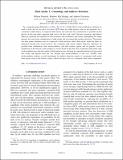Dark nuclei. I. Cosmology and indirect detection
Author(s)
Detmold, William; Pochinsky, Andrew; McCullough, Matthew P.
DownloadPhysRevD.90.115013.pdf (641.3Kb)
PUBLISHER_POLICY
Publisher Policy
Article is made available in accordance with the publisher's policy and may be subject to US copyright law. Please refer to the publisher's site for terms of use.
Terms of use
Metadata
Show full item recordAbstract
In a companion paper Detmold et al. [Phys. Rev. D 90, 114506 (2014)]PRVDAQ1550-799810.1103/PhysRevD.90.114506, lattice field theory methods are used to show that in two-color, two-flavor QCD there are stable nuclear states in the spectrum. As a commonly studied theory of composite dark matter, this motivates the consideration of possible nuclear physics in this and other composite dark sectors. In this work, early Universe cosmology and indirect detection signatures are explored for both symmetric and asymmetric dark matter, highlighting the unique features that arise from considerations of dark nuclei and associated dark nuclear processes. The present day dark matter abundance may be composed of dark nucleons and/or dark nuclei, where the latter are generated through dark nucleosynthesis. For symmetric dark matter, indirect detection signatures are possible from annihilation, dark nucleosynthesis, and dark nuclear capture and we present a novel explanation of the Galactic center gamma ray excess based on the latter. For asymmetric dark matter, dark nucleosynthesis may alter the capture of dark matter in stars, allowing for captured particles to be processed into nuclei and ejected from the star through dark nucleosynthesis in the core. Notably, dark nucleosynthesis realizes a novel mechanism for indirect detection signals of asymmetric dark matter from regions such as the Galactic center, without having to rely on a symmetric dark matter component.
Date issued
2014-12Department
Massachusetts Institute of Technology. Center for Theoretical Physics; Massachusetts Institute of Technology. Department of Physics; Massachusetts Institute of Technology. Laboratory for Nuclear ScienceJournal
Physical Review D
Publisher
American Physical Society
Citation
Detmold, William, Matthew McCullough, and Andrew Pochinsky. "Dark nuclei. I. Cosmology and indirect detection." Phys. Rev. D 90, 115013 (December 2014). © 2014 American Physical Society
Version: Final published version
ISSN
1550-7998
1550-2368